In my potpourri session at the TM, I referred to one rug as having a
pattern of tessellation, but just what is a tessellation? A tessellation
is a pattern formed by the repetition of a single unit or shape that, when
repeated, fills the plane with no gaps and no overlaps. Familiar examples
of tessellations are the patterns formed by paving stones or bricks, and
cross-sections of beehives. It is interesting that in the tessellation rug
one need not read the white as being ground and the colors as being
pattern. Both are pattern. The following drawing illustrates the
construction of the tessellation in my rug. As you can see, the
tessellation consists of a field of triangles that are alternately colored
so as to create what the eye perceives as something of an "S" shape or
what John and others may refer to as a "bird on a pole," although it is my
view that no bird is actually represented. 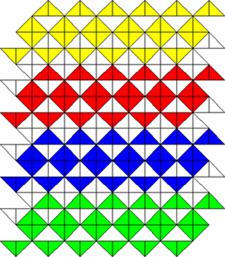 The next series of images
begins with a detail of the tessellation rug itself, followed by the first
drawing of a single row of the "S" shapes in which I have alternated
colors so that one can see the single elements of each row. The next series of images
begins with a detail of the tessellation rug itself, followed by the first
drawing of a single row of the "S" shapes in which I have alternated
colors so that one can see the single elements of each row. 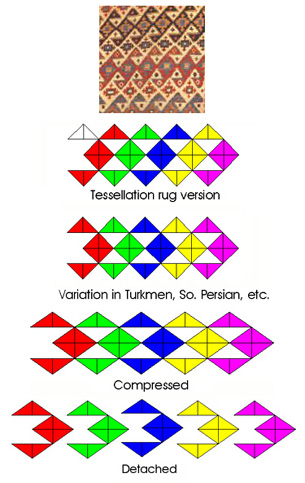 One could say that the basic
building block creating the tessellation is either the "S" shape alone or
an entire row of them. In the second drawing labeled "variation in
Turkmen, So. Persian, etc." you will observe how the single alternation of
color in the top triangle now creates something of an "arrow." I need to
point out that single lines of what I labeled the "tessellation rug
version" also appear in Turkmen and South Persian rugs (and many others)
as well, but not, to my knowledge, ever as a tessellation. The drawing
labeled "compressed" shows how the row changes shape, as often happens in
pile weaving, when the design is compressed through the weaving process.
The last drawing labeled "detached" illustrates how a weaver or culture
may view the elements in isolation. Carpets with a tessellation are
relatively rare. There Textile Museum has an Afshar khordjin in sumak of a
tessellation and I can post an image of another. It seems to me that
tessellations are more common in tile work and brickwork, which may be
where these designs originated. It is impossible to determine, of course,
the chronology of the development of these designs and how the concept
migrated from one medium to another. It seems likely that the "S" shape as
we see it in the tessellation predate tessellations themselves. And so may
the "arrow" variation. I find this sort of interplay shapes and designs in
Islamic art to be fascinating and find few parallels in Western art,
although Escher's work stands as one major exception. Perhaps others could
cite examples of tessellations in weavings. Wendel One could say that the basic
building block creating the tessellation is either the "S" shape alone or
an entire row of them. In the second drawing labeled "variation in
Turkmen, So. Persian, etc." you will observe how the single alternation of
color in the top triangle now creates something of an "arrow." I need to
point out that single lines of what I labeled the "tessellation rug
version" also appear in Turkmen and South Persian rugs (and many others)
as well, but not, to my knowledge, ever as a tessellation. The drawing
labeled "compressed" shows how the row changes shape, as often happens in
pile weaving, when the design is compressed through the weaving process.
The last drawing labeled "detached" illustrates how a weaver or culture
may view the elements in isolation. Carpets with a tessellation are
relatively rare. There Textile Museum has an Afshar khordjin in sumak of a
tessellation and I can post an image of another. It seems to me that
tessellations are more common in tile work and brickwork, which may be
where these designs originated. It is impossible to determine, of course,
the chronology of the development of these designs and how the concept
migrated from one medium to another. It seems likely that the "S" shape as
we see it in the tessellation predate tessellations themselves. And so may
the "arrow" variation. I find this sort of interplay shapes and designs in
Islamic art to be fascinating and find few parallels in Western art,
although Escher's work stands as one major exception. Perhaps others could
cite examples of tessellations in weavings. Wendel |
 The next series of images
begins with a detail of the tessellation rug itself, followed by the first
drawing of a single row of the "S" shapes in which I have alternated
colors so that one can see the single elements of each row.
The next series of images
begins with a detail of the tessellation rug itself, followed by the first
drawing of a single row of the "S" shapes in which I have alternated
colors so that one can see the single elements of each row.  One could say that the basic
building block creating the tessellation is either the "S" shape alone or
an entire row of them. In the second drawing labeled "variation in
Turkmen, So. Persian, etc." you will observe how the single alternation of
color in the top triangle now creates something of an "arrow." I need to
point out that single lines of what I labeled the "tessellation rug
version" also appear in Turkmen and South Persian rugs (and many others)
as well, but not, to my knowledge, ever as a tessellation. The drawing
labeled "compressed" shows how the row changes shape, as often happens in
pile weaving, when the design is compressed through the weaving process.
The last drawing labeled "detached" illustrates how a weaver or culture
may view the elements in isolation. Carpets with a tessellation are
relatively rare. There Textile Museum has an Afshar khordjin in sumak of a
tessellation and I can post an image of another. It seems to me that
tessellations are more common in tile work and brickwork, which may be
where these designs originated. It is impossible to determine, of course,
the chronology of the development of these designs and how the concept
migrated from one medium to another. It seems likely that the "S" shape as
we see it in the tessellation predate tessellations themselves. And so may
the "arrow" variation. I find this sort of interplay shapes and designs in
Islamic art to be fascinating and find few parallels in Western art,
although Escher's work stands as one major exception. Perhaps others could
cite examples of tessellations in weavings. Wendel
One could say that the basic
building block creating the tessellation is either the "S" shape alone or
an entire row of them. In the second drawing labeled "variation in
Turkmen, So. Persian, etc." you will observe how the single alternation of
color in the top triangle now creates something of an "arrow." I need to
point out that single lines of what I labeled the "tessellation rug
version" also appear in Turkmen and South Persian rugs (and many others)
as well, but not, to my knowledge, ever as a tessellation. The drawing
labeled "compressed" shows how the row changes shape, as often happens in
pile weaving, when the design is compressed through the weaving process.
The last drawing labeled "detached" illustrates how a weaver or culture
may view the elements in isolation. Carpets with a tessellation are
relatively rare. There Textile Museum has an Afshar khordjin in sumak of a
tessellation and I can post an image of another. It seems to me that
tessellations are more common in tile work and brickwork, which may be
where these designs originated. It is impossible to determine, of course,
the chronology of the development of these designs and how the concept
migrated from one medium to another. It seems likely that the "S" shape as
we see it in the tessellation predate tessellations themselves. And so may
the "arrow" variation. I find this sort of interplay shapes and designs in
Islamic art to be fascinating and find few parallels in Western art,
although Escher's work stands as one major exception. Perhaps others could
cite examples of tessellations in weavings. Wendel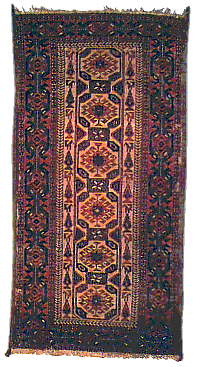 Has this been a
field design that became a border design? The field design of this Belouch
appears mostly as border design.
Has this been a
field design that became a border design? The field design of this Belouch
appears mostly as border design. 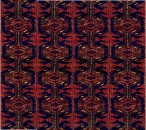 Is it tesselating enough? Best regards,
Vincent
Is it tesselating enough? Best regards,
Vincent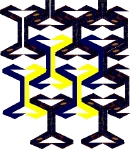 Here's an
example I made from the Belouch design. The "serpent" setting, makes the
design, and the transformation. It depends on which item the artist
highlights. I do not think it's a drammtic event like making a triangle
transform into the next triangle, or a square becoming a square. I do
think the transformation of one design into the next mostly depends on the
perception of the viewer. What is it you wish to see? What are you
programmed to see? In my Belouch-border, I saw two designs until I made it
a field design. I couldn't do it with the "crosslike" design. But when I
took the "serpent", it wasn't so difficult. Ganzhorn wanted me to
"believe" the cross design was first. As the image shows, it wasn't. Which
brings me to the next question. What design was first? The border or the
field design? In this Belouch, I think the border design has been a
tessellating design to start with. And the field design in this Belouch
has become a border design in more recent Belouch rugs. So could this be
an aspect by which we could identify the "age" of a rug or it's design?
Best regards, Vincent
Here's an
example I made from the Belouch design. The "serpent" setting, makes the
design, and the transformation. It depends on which item the artist
highlights. I do not think it's a drammtic event like making a triangle
transform into the next triangle, or a square becoming a square. I do
think the transformation of one design into the next mostly depends on the
perception of the viewer. What is it you wish to see? What are you
programmed to see? In my Belouch-border, I saw two designs until I made it
a field design. I couldn't do it with the "crosslike" design. But when I
took the "serpent", it wasn't so difficult. Ganzhorn wanted me to
"believe" the cross design was first. As the image shows, it wasn't. Which
brings me to the next question. What design was first? The border or the
field design? In this Belouch, I think the border design has been a
tessellating design to start with. And the field design in this Belouch
has become a border design in more recent Belouch rugs. So could this be
an aspect by which we could identify the "age" of a rug or it's design?
Best regards, Vincent Best
regards, Wendel
Best
regards, Wendel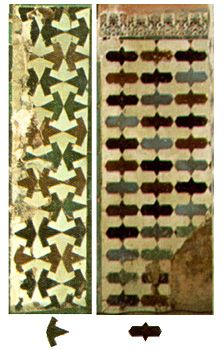 Here is another
tessellation from the walls of the Alhambra, this one perhaps a bit more
relevant to what might be called a "twirling bird" element in my rug.
Here is another
tessellation from the walls of the Alhambra, this one perhaps a bit more
relevant to what might be called a "twirling bird" element in my rug. 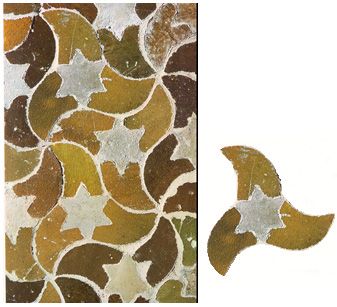 I find the sense of
rotation and movement to be intriguing and pleasing. It is amazing what
can be achieved with such deceptively simple elements. Best,
Wendel
I find the sense of
rotation and movement to be intriguing and pleasing. It is amazing what
can be achieved with such deceptively simple elements. Best,
Wendel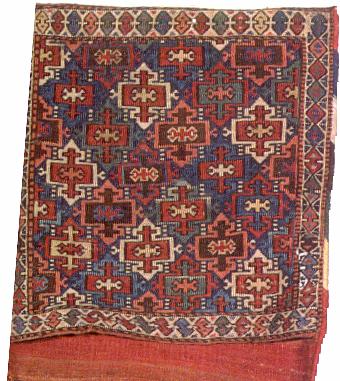 This is one half of a complete
khorjin set that appeared this week in a local Washington area auction.
When I first looked at its design, I thought it might possibly be
tesselated but I think it is not quite. First, it is obvious that the
devices don’t actually fit together as do the ones in Wendel’s rug but
there is a further thing to notice as well. The ground color behind the
devices appears to me to be uniform. If each of the “diamond” areas
immediately surrounding each of these devices were a different color and
if they touched this bag face would then have a tesselated design on the
same grounds that we have acknowledged that most Jaf Kurd bag faces with
the diamond designs also have. Note also that these diamond instances of
tesselation are not very remarkable or very interesting instances of it.
Part of what attracts our attention to the instance of tesselation in
Wendel’s rug is, I think, that it is rather unexpected. When one looks at
this device as I do daily in an untesselated version in the main border of
a Yomud chuval, one does not quickly suspect that it might be a candidate
for tesselated usage. It think this is one of the sources of attraction in
the Escher tesselations that Wendel has mentioned. They are often rather
complex and also it is to some extent surprising that they fit together
perfectly and the eye experiences this complexity and violation of
expectation favorably. By the way, I went on a brief web search for some
instances of Escher’s tesselations and found these two of surprising
complexity:
This is one half of a complete
khorjin set that appeared this week in a local Washington area auction.
When I first looked at its design, I thought it might possibly be
tesselated but I think it is not quite. First, it is obvious that the
devices don’t actually fit together as do the ones in Wendel’s rug but
there is a further thing to notice as well. The ground color behind the
devices appears to me to be uniform. If each of the “diamond” areas
immediately surrounding each of these devices were a different color and
if they touched this bag face would then have a tesselated design on the
same grounds that we have acknowledged that most Jaf Kurd bag faces with
the diamond designs also have. Note also that these diamond instances of
tesselation are not very remarkable or very interesting instances of it.
Part of what attracts our attention to the instance of tesselation in
Wendel’s rug is, I think, that it is rather unexpected. When one looks at
this device as I do daily in an untesselated version in the main border of
a Yomud chuval, one does not quickly suspect that it might be a candidate
for tesselated usage. It think this is one of the sources of attraction in
the Escher tesselations that Wendel has mentioned. They are often rather
complex and also it is to some extent surprising that they fit together
perfectly and the eye experiences this complexity and violation of
expectation favorably. By the way, I went on a brief web search for some
instances of Escher’s tesselations and found these two of surprising
complexity: 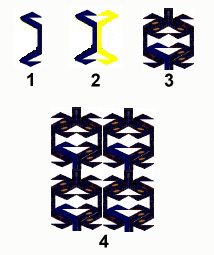 #1 is your basic
shape and it is reflected so as to create #2. In spite of the fact that
only the basic shape is needed to create your Belouch pattern, the shape
fails to completely fill the space. In #3, I took extracted one portion of
the complete pattern so as to create a shape that could be translated
three times to recreate the complete pattern as in #4. Yet all of the
white portions are gaps because the outline or shape of #3 does not
interconnect with itself so as to eliminate those gaps. One could argue,
as is sometimes done with some of Escher's works, that a tessellation is
created when the square frame of the shape #3 is repeated so as to cover
the space. However, that is a tessellation of squares, not a tessellation
of shapes #1, 2 or 3. Best regards, Wendel
#1 is your basic
shape and it is reflected so as to create #2. In spite of the fact that
only the basic shape is needed to create your Belouch pattern, the shape
fails to completely fill the space. In #3, I took extracted one portion of
the complete pattern so as to create a shape that could be translated
three times to recreate the complete pattern as in #4. Yet all of the
white portions are gaps because the outline or shape of #3 does not
interconnect with itself so as to eliminate those gaps. One could argue,
as is sometimes done with some of Escher's works, that a tessellation is
created when the square frame of the shape #3 is repeated so as to cover
the space. However, that is a tessellation of squares, not a tessellation
of shapes #1, 2 or 3. Best regards, Wendel